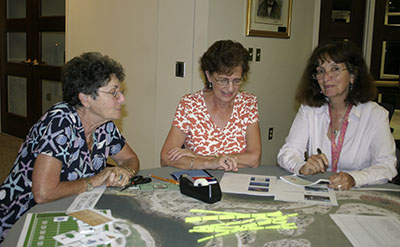A handful of residents attended a workshop Tuesday to discuss plans for a large-scale dog park at Royal Palm Beach Commons Park.
Royal Palm Beach Village Engineer Chris Marsh led the workshop, which was also attended by village staff and elected officials.
Marsh explained the materials provided for the workshop, which included 90,000 “dog dollars” that the village has allotted for development of the 4.15-acre park.
Also provided were giant maps at each table for participants to do their planning; pipe cleaner fences; a gauge to measure distances on the maps; and symbols depicting benches, tables, pavilions and landscaping.
Marsh did a PowerPoint presentation on how the session would be conducted, including examples of existing dog parks in the village and the surrounding area.
The village currently has three small dog parks: Crestwood Park (0.74 acre), Robiner Park (0.47 acre) and Home Place Park (0.43 acre). All have shaded or covered seating and water available, including a dog wash. Crestwood and Home Place have separate areas for large and small dogs.
“They are spread evenly throughout the village, and if you look at the newest addition, which will be the Royal Palm Beach Commons Dog Park, geographically it makes sense as the fourth addition,” Marsh said.
As examples of larger dog parks, he also showed diagrammed maps of the Wellington Dog Park on Greenbriar Blvd. (5.1 acres), Pooch Pines Dog Park at Okeeheelee Park (2.97 acres), Canine Cove in Boca Raton (3.4 acres), Lake Ida West Dog Park in Delray Beach (2.8 acres) and Pompano Beach Dog Park (1.97 acres).
“Many of you have visited these parks, and it will give you an idea of how to lay this park out,” Marsh said.
The master plan for Commons Park was amended earlier this year to include a dog park and a community garden.
Marsh explained that the council approved a budget of $63,000 for the dog park in 2013 and budgeted another $30,000 for 2014, increasing the budget to $93,000.
“We will take the concepts from this evening’s meeting and present them to the council for site plan approval at either the last meeting in January or the first meeting in February,” he said. “After staff knows what we’re doing, it will take six to eight months to design and advertise the project, and an additional four to six months to construct it.”
The nine residents were divided into three groups to formulate ideas for the park.
“Each group gets 90,000 in dog dollars, which we printed out to keep you within the budget,” Marsh said. “Your goal is to create a dog park within that budget. This is a group effort. All members of the team will be given equal opportunity to provide input.”
He emphasized that residents using the community garden would need access and that workshop participants would need to make that access part of the design.
The “dog park catalog” included $18,000 for a 14-foot-by-18-foot pavilion; $20,000 for a 25-foot, covered hexagonal doggie gym set; $16,000 for a 625-square-foot covered picnic area with concrete pad; $500 per waste bin; $1,500 for a dog water fountain; $5,000 for a dog wash; $5,000 for dog agility equipment; $300 per foot for shade trees; $900 per park bench; $1,500 per picnic table; $2,000 per handicapped parking space; $30 per linear foot for 4-foot-wide concrete paths; $15,000 for a water meter; $5 per foot for water lines; and $30 per foot for fencing.
Marsh said that a good dog park requires sufficient size to avoid crowding, drinking water and shade, materials for cleanup after the dogs, two-gate entrances, and separate sections for large and small dogs. He recommended that participants start with the most important features and then build around them.
“As you identify features that will be incorporated into the park, start to set aside the dollars that you are going to set aside for that,” he instructed.
One resident asked whether grants could be included in the plans for amenities, and Marsh recommended staying within the budget for now.
“We can talk about what we’d like in the future, but for purposes of this workshop, we really want to get a concept within budget, and then we can talk about future grants or appropriations,” he said.
Marsh added that eight royal palms are available that could be transplanted from Royal Palm Beach Blvd. at no cost because FPL is requiring the village to move them.
ABOVE: Residents Susan Weinstein, Kathy Schultz and Caren Griffen take part in the workshop.





